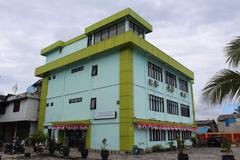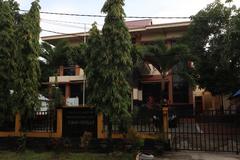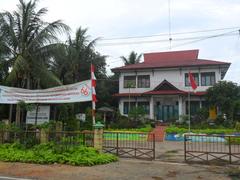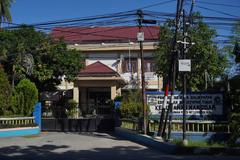
Guide to Visiting Balikpapan Kota, Balikpapan, Indonesia
Date: 16/08/2024
Introduction
Balikpapan Kota, located on the eastern coast of Borneo Island in Indonesia, is a city rich in history, culture, and natural beauty. This comprehensive guide delves into the historical evolution, modern attractions, economic significance, and practical travel tips to help visitors make the most of their trip to Balikpapan. Known for its early beginnings as a small fishing village, the city’s name, Balikpapan, derives from the Dayak language, meaning ‘behind the firewood’ (facts.net). The Dutch colonial era left a significant mark on the city, with the discovery of oil reserves in the early 20th century catalyzing its transformation into an economic hub (Kompas). During World War II, Balikpapan’s strategic location and oil reserves made it a key target, leading to intense battles and significant reconstruction efforts post-war (Britannica). Today, Balikpapan thrives as a modern industrial hub with diverse attractions, from pristine beaches and wildlife sanctuaries to cultural landmarks and bustling markets. This guide aims to provide a detailed overview of the top attractions, visiting hours, ticket prices, and essential travel tips to ensure a memorable visit.
Exploring Balikpapan: Historical Sites, Visiting Hours, and Tickets
Introduction
Balikpapan, located on the eastern coast of Borneo Island in Indonesia, boasts a rich historical background, vibrant cultural heritage, and stunning natural beauty. Whether you are a history enthusiast, nature lover, or adventurous traveler, Balikpapan offers an unforgettable experience. This article delves into the city’s historical sites, visiting hours, ticket prices, and practical travel tips to help you plan your visit.
Historical Background of Balikpapan Kota, Balikpapan, Indonesia
Early Beginnings and Etymology
Balikpapan, originally a small fishing village, derives its name from the local Dayak language, meaning ‘behind the firewood.’ This name references the village’s location behind a prominent pile of firewood used for navigational purposes (facts.net). According to legend, the name also stems from an incident involving the construction of a palace in Kutai Lama, where wooden planks returned, giving rise to the name Balikpapan (Kompas).
Colonial Era and Economic Development
During the colonial era, the Dutch recognized Balikpapan’s strategic location and natural resources. The early 20th century saw the discovery of oil reserves, significantly transforming the city. The establishment of one of Indonesia’s largest oil refineries spurred economic growth and attracted a diverse population (facts.net).
World War II and Its Impact
Balikpapan’s strategic location and oil made it a key target during World War II. The city witnessed intense battles between Allied and Japanese forces, leading to significant destruction, including the sabotage of oil facilities by retreating Dutch forces (facts.net). The Battle of Balikpapan in 1945 marked the city’s liberation and the beginning of its reconstruction.
Post-Independence Era and Modern Development
Post-independence, Balikpapan continued to grow as an economic hub. The oil industry, along with coal mining, natural gas, and other industries, drove the city’s modernization. Balikpapan’s strategic location made it a vital logistics and distribution center in the region (facts.net).
Visitor Information
Visiting Hours and Tickets
Most historical sites and attractions in Balikpapan are open daily from 8:00 AM to 5:00 PM. Ticket prices vary depending on the attraction, with historical sites typically ranging from IDR 10,000 to IDR 50,000. It is advisable to check the official websites for the latest information on visiting hours and ticket prices.
Travel Tips
- Best Time to Visit: The best time to visit Balikpapan is during the dry season, from May to September, to avoid heavy rainfall.
- Transportation: Taxis and ride-hailing services are widely available. Renting a car or motorbike is also an option for exploring the city.
- Accommodation: Balikpapan offers a range of accommodation options, from budget hostels to luxury hotels.
Cultural Heritage and Modern Attractions
Despite rapid modernization, Balikpapan preserves its cultural heritage. The city hosts various cultural festivals, art exhibitions, and traditional performances. Balikpapan’s beaches, such as Manggar Beach, are popular for their natural beauty and sea turtle conservation efforts (facts.net). The city also serves as a gateway to Kutai National Park, home to rare species like orangutans and proboscis monkeys.
FAQ
Q: What are the visiting hours for Balikpapan’s main attractions?
A: Most attractions are open daily from 8:00 AM to 5:00 PM. Check official websites for specific details.
Q: How much do tickets cost for Balikpapan’s historical sites?
A: Ticket prices typically range from IDR 10,000 to IDR 50,000, depending on the site.
Conclusion
Balikpapan’s history, cultural heritage, and natural attractions make it a dynamic city worth exploring. With practical visitor information, you can plan a memorable trip to this fascinating destination. Don’t forget to check out other related posts and follow us on social media for more updates.
The Economic Evolution of Balikpapan: From Oil Discovery to Modern Industrial Hub
Introduction
Balikpapan, located in East Kalimantan, Indonesia, has undergone a remarkable economic transformation since the late 19th century. From its early days as an oil discovery site to becoming a modern industrial hub, Balikpapan’s economic journey is a testament to its strategic importance and resilience. This article explores the historical significance, modern economic landscape, strategic importance, and future prospects of this vital city.
Historical Economic Development
Balikpapan’s historical economic significance began in 1899 with the discovery of oil fields operated by British-American-Dutch interests. The first oil well, known as Mathilda, was drilled on February 10, 1897, marking the beginning of Balikpapan’s journey as a major oil producer (IDN Times).
During World War II, the oil refinery in Balikpapan was destroyed in 1942 as part of a scorched-earth policy to prevent Japanese forces from utilizing it. However, the refinery was rebuilt post-war, continuing its role as a critical component of the city’s economy (Britannica).
Modern Economic Landscape
Balikpapan’s economy has evolved significantly over the years. Today, it is a bustling hub for various industries, including oil refining, coal mining, and trade. The city processes both imported and local crude oils, making it a vital player in Indonesia’s energy sector. The presence of natural resources such as coal and petroleum has made Balikpapan a magnet for job seekers, investors, and producers (IJISRT).
Industrial and Trade Sectors
The industrial sector in Balikpapan is diverse, with a strong emphasis on oil refining and coal mining. The city’s oil production once reached 86 million barrels per year, highlighting its capacity and significance in the global oil market (IDN Times). Additionally, the processing industry sector is considered the heart of Balikpapan’s economy, contributing significantly to both local and provincial needs (IJISRT).
Economic Growth and Development
Balikpapan’s economic growth is closely linked to the broader economic development of East Kalimantan. The city’s Gross Regional Domestic Product (GRDP) has shown progressive growth, driven by its industrial activities. The processing industry sector, in particular, has been identified as a leading economic sector, contributing to both domestic and regional economic needs (IJISRT).
Strategic Importance
Balikpapan holds strategic importance in Indonesia’s Master Plan for Development and Expansion of the Indonesian Economy (MP3EI). The city is projected as a corridor for main economic activities in Kalimantan, serving as a crucial entry point to the new Indonesian capital in East Kalimantan. This strategic positioning enhances Balikpapan’s role as a supporting muscle for the development of the Archipelago Capital City (IKN) (IJISRT).
Infrastructure and Connectivity
Balikpapan’s infrastructure is well-developed, with key facilities such as the Sultan Aji Muhammad Sulaiman Sepinggan International Airport and the Semayang Port. These facilities enhance the city’s connectivity, making it a vital gateway for goods and services. The airport, in particular, plays a significant role in facilitating the flow of labor and mobility of goods, contributing to the city’s economic dynamism (IDN Times).
Investment and Economic Potential
Balikpapan’s economic potential is further highlighted by its attractiveness to investors. The city has seen substantial investments in both the domestic and foreign sectors, driven by its competitive advantages in natural resources and industrial capabilities. The processing industry sector, in particular, has shown significant potential for growth, with the ability to meet both local and regional demands (IJISRT).
Future Prospects
The future economic prospects of Balikpapan are promising, especially with the ongoing development of the new Indonesian capital in East Kalimantan. The city’s strategic location and robust industrial base position it well to support the capital’s development. Additionally, policies aimed at enhancing sector growth in Balikpapan are expected to further boost its economic potential (IJISRT).
Economic Landmarks and Visitor Information
Visitors to Balikpapan can explore various economic landmarks that highlight the city’s rich industrial history. Guided tours of historical industrial sites and the modern refinery can provide an in-depth understanding of Balikpapan’s economic evolution. Notable places for photography include the Mathilda oil well and the bustling Semayang Port. Travel tips include visiting during economic festivals or special events that celebrate the city’s economic heritage.
FAQ
Q: What is the main industry in Balikpapan?
A: The main industries in Balikpapan are oil refining, coal mining, and trade.
Q: How has Balikpapan’s economy evolved over the years?
A: Balikpapan has evolved from an oil discovery site to a modern industrial hub with diverse industries including oil refining, coal mining, and trade.
Q: What makes Balikpapan a strategic economic hub?
A: Balikpapan’s strategic location, robust industrial base, and well-developed infrastructure make it a key economic hub in East Kalimantan and Indonesia.
Conclusion
Balikpapan’s economic significance is deeply rooted in its history and continues to evolve with modern developments. The city’s strategic importance, robust industrial sector, and promising future prospects make it a key player in Indonesia’s economic landscape. As Balikpapan continues to grow and develop, it remains a vital hub for industry, trade, and investment in East Kalimantan.
Call to Action
Stay up to date with the latest developments in Balikpapan by following our updates on social media, downloading the mobile app Audiala, and checking out other related posts on our website.
Explore Balikpapan: Top Attractions, Visiting Hours, and Travel Tips
Balikpapan Kota in Indonesia is a hidden gem that offers a rich blend of natural beauty, cultural heritage, and vibrant local life. Whether you’re seeking adventure, relaxation, or a cultural experience, Balikpapan has something for everyone. Here’s your guide to the top attractions, visiting hours, and travel tips to make the most of your visit.
Beaches and Waterfronts
Kemala Beach
Kemala Beach is a popular destination for both locals and tourists. Known for its clean sands and laid-back vibe, it offers a perfect escape from the urban jungle. The beach is lined with cafes and restaurants where visitors can enjoy local cuisine while taking in the scenic views. The beach is typically open all day, from early morning to late evening (Lonely Planet).
Manggar Segarasari Beach
Another must-visit beach is Manggar Segarasari Beach, famous for its stunning sunsets and clear waters. This beach is ideal for swimming, snorkeling, and other water activities. It is a favorite spot for families and groups looking to spend a relaxing day by the sea (Guides2Travel).
Nature and Wildlife
Samboja Lestari Orangutan Sanctuary
Samboja Lestari is a project by the Borneo Orangutan Survival Foundation, housing over 150 orangutans on a series of islands. This sanctuary provides a unique opportunity to observe these incredible creatures in a semi-natural habitat. The sanctuary also focuses on the conservation of sun bears, making it a dual-purpose visit for wildlife enthusiasts. Visiting hours are typically from 8 AM to 4 PM daily (Lonely Planet).
KWPLH Sun Bear Conservation Center
The KWPLH Sun Bear Conservation Center is another significant attraction for animal lovers. The center is dedicated to the conservation of sun bears and provides informative tours about the plight of Kalimantan’s wildlife. Visitors can learn about the challenges these animals face and the efforts being made to protect them. The center is open from 9 AM to 5 PM (Lonely Planet).
Sungai Wain Protection Forest
For those interested in exploring primary lowland forests, the Sungai Wain Protection Forest is a must-visit. This protected area is home to various species, including orangutans, birds, and other wildlife. Guided tours are available, often starting early in the morning to maximize wildlife sightings. It’s advisable to check with local tour operators for specific visiting hours and ticket prices (Guides2Travel).
Urban Parks and Recreational Areas
Bekapai Park
Bekapai Park is a beautiful urban park offering a peaceful retreat from the city’s hustle and bustle. The park features lush green spaces, walking paths, and various recreational facilities. Visitors can enjoy the scenic lake, playgrounds, and vibrant gardens, making it an ideal spot for families, nature lovers, and outdoor enthusiasts. The park is open 24 hours a day (Guides2Travel).
Cultural and Historical Sites
Masjid Agung At-Taqwa
Masjid Agung At-Taqwa is an impressive mosque adorned with complex Islamic geometrical patterns. It is particularly stunning at night when it is lit up in multicolored splendor. The mosque is a significant cultural and religious site in Balikpapan, attracting both worshippers and tourists. Visiting hours are from 4 AM to 10 PM (Lonely Planet).
Shopping and Markets
Pasar Inpres
Pasar Inpres is a traditional market where visitors can immerse themselves in the local culture. The market offers a variety of goods, including fresh produce, local delicacies, and handmade crafts. It is an excellent place to experience the daily life of Balikpapan’s residents and to purchase unique souvenirs. The market is typically open from 6 AM to 6 PM (Guides2Travel).
Pasar Segar
Pasar Segar is another bustling market known for its fresh seafood. Visitors can indulge in delicious seafood dishes and explore the vibrant market atmosphere. It is a popular spot for both locals and tourists looking to enjoy Balikpapan’s culinary delights. The market operates from 6 AM to 5 PM (Guides2Travel).
Adventure and Outdoor Activities
Bukit Bangkirai
Bukit Bangkirai offers an adventurous experience with its canopy bridge standing 30 meters above the ground. The bridge provides an impressive view of the old-growth dipterocarp trees and an adrenaline rush for those who dare to cross it. The area is also a great spot for hiking and exploring the rich biodiversity of Kalimantan’s rainforests. The site is open from 8 AM to 5 PM, and guided tours are available (Lonely Planet).
Penangkaran Buaya
Penangkaran Buaya is a crocodile farm and sanctuary where visitors can learn about these fascinating reptiles. The farm offers guided tours that provide insights into the life and conservation of crocodiles. It is an educational and thrilling experience for visitors of all ages. The farm is open from 9 AM to 4 PM (Discoveryourindonesia).
Day Trips and Excursions
Derawan Islands
For those seeking adventure beyond Balikpapan, a day trip to the nearby Derawan Islands is highly recommended. The islands offer excellent opportunities for snorkeling, diving, and island hopping. The crystal-clear waters and vibrant marine life make it a paradise for underwater enthusiasts. Boat tripsusually depart early in the morning, and it’s best to book in advance (Guides2Travel).
Agrotourism Park
The Agrotourism Park is another excellent day-trip option. The park features exotic tropical plants and open-air picnic spots, making it a perfect destination for nature lovers. Visitors can explore the diverse flora and enjoy a relaxing day in a beautiful natural setting. The park is open from 8 AM to 6 PM (Traveloka).
Practical Information
Getting Around
Balikpapan offers several transportation options for getting around the city. Taxis, ride-hailing services, and rental cars are readily available. Traditional local transportation such as angkot (minibusses) and ojek (motorcycle taxis) provide a unique experience. For greater flexibility, renting a scooter or motorcycle can be a convenient way to navigate the city (Guides2Travel).
Best Time to Visit
The best time to visit Balikpapan is during the dry season, which typically occurs between May and September. During this time, visitors can enjoy pleasant weather and partake in various outdoor activities without the interference of heavy rainfall. However, it is always advisable to check the weather forecast before planning your trip (Guides2Travel).
Safety Tips
Balikpapan is generally considered safe for tourists. However, it is always advisable to stay cautious and be aware of your surroundings, especially when exploring unfamiliar areas or at night. Safeguarding your belongings and taking necessary precautions is wise, as with any travel destination (Guides2Travel).
FAQ
What are the best times to visit Kemala Beach?
The best times to visit Kemala Beach are early morning and late evening when the weather is cooler and the beach is less crowded.
How to get to Samboja Lestari Orangutan Sanctuary?
Samboja Lestari Orangutan Sanctuary can be reached by car or taxi from Balikpapan city center. It is advisable to book a guided tour for a more informative experience.
Conclusion
By exploring these attractions and activities, visitors to Balikpapan Kota can experience the rich natural beauty, cultural heritage, and vibrant local life that this unique city has to offer. Make sure to plan your visit according to the best times and visiting hours to fully enjoy everything Balikpapan has to offer.
For more travel tips and guides, download the Audiala mobile app or follow us on social media.
Conclusion
Balikpapan Kota is a city that seamlessly blends its historical roots with modern development, making it a unique destination for travelers. From its early days as a strategic oil discovery site to its current status as an industrial hub, Balikpapan’s economic evolution is a testament to its resilience and strategic importance (IDN Times). Visitors can explore a range of attractions, including the serene Kemala Beach, the wildlife-rich Samboja Lestari Orangutan Sanctuary, and the culturally significant Masjid Agung At-Taqwa (Lonely Planet). The city’s well-developed infrastructure and strategic location make it an ideal gateway for further exploration of East Kalimantan, including day trips to the Derawan Islands and the Agrotourism Park (Traveloka). Whether you are a history enthusiast, nature lover, or adventure seeker, Balikpapan offers a rich and diverse experience. For the latest updates and travel tips, visitors are encouraged to download the Audiala mobile app and follow related posts on social media.
References
- Facts.net, 2021, 38 Facts About Balikpapan.
- Kompas, 2021, Asal Usul Balikpapan dan Cerita Perahu Papan Terbalik.
- Britannica, 2021, Balikpapan.
- IDN Times, 2021, Asal Usul dan Sejarah Singkat Kota Balikpapan.
- IJISRT, 2024, Economic Evolution of Balikpapan.
- Lonely Planet, 2024, Balikpapan Attractions.
- Guides2Travel, 2024, What to See in Balikpapan.
- Discoveryourindonesia, 2024, Balikpapan Travel Guide.
- Traveloka, 2024, Balikpapan Destination.



